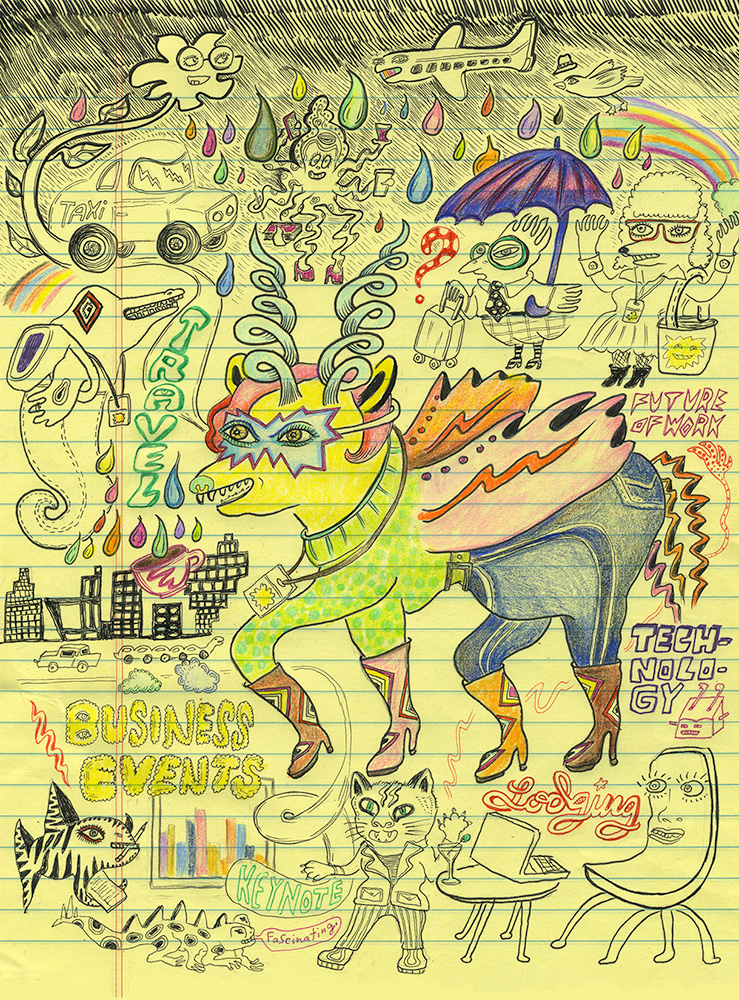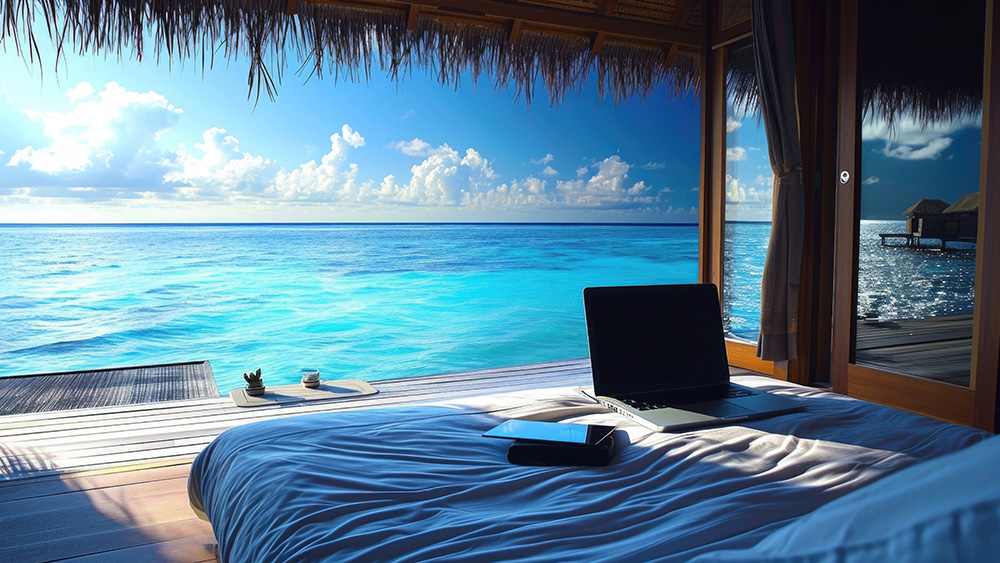
Illustration by Julie Murphy
Annual Events Industry Forecast
Our usual approach to Convene‘s Annual Industry Forecast is to cast a wide net, gathering a variety of data related to the business events industry, including travel, lodging, technology, and the workplace. This year, we took a different tack. Instead of those wide-ranging forecasts, Convene editors wrote succinct trends reports for each sector. We’ve sifted through the research to come up with a few signposts to help you navigate the year ahead, whatever course it takes. And, as always, the Forecast includes our Annual Meetings Market Survey, which gives us a strong sense of where we stand at this moment in time — the ups, the downs, the challenges, and our overall mood.

Bleisure travel has accelerated post-COVID — and 67 percent of bleisure trips begin with a conference on the itinerary.
If you think the post-COVID hotel staffing shortage is getting better, think again. According to an American Hotel & Lodging Association (AHLA) study from May 2024, more than three-quarters (76 percent) of surveyed hotels reported staffing shortages, with 13 percent noting the shortage was “severe” — and this is an increase from earlier in the year, when 67 percent of hoteliers indicated they were understaffed and 12 percent called the gap “severe.”
What’s happening? A report from Phocuswright by Northstar cites a decline in college enrollment in recent years, “and among those who do aspire to a secondary education, fewer are choosing careers in hospitality,” the report said. “Reasons vary, but concerns about long hours, low pay, and lack of remote work options have prompted many prospects to focus on other sectors.” For those who have chosen to pursue hospitality, mentorship opportunities can be limited: “Following the pandemic, many of the most experienced executives have moved on to other hotel companies, formed consulting practices of their own, or retired.”
The ongoing hospitality talent crisis continues to make it challenging for event organizers to work with their host hotels throughout the planning process due to a lack of responsiveness — something that keeps 41 percent of planners awake at night, according to Development Counsellors International’s (DCI) most recent insights report.
The other trend that kept reappearing as I looked into lodging data — bleisure — is more on the positive side. While not an unfamiliar phenomenon for planners, the practice of tacking time onto business travel has accelerated post-COVID, especially among Millennials. A whopping 67 percent of bleisure trips begin with a conference on the itinerary, meaning that event organizers need to pay close attention to the hotels they partner with and the quality of the experience from the attendees’ perspective, from housekeeping to the level of service they receive throughout their stay. Continued interest in combining business with pleasure makes destination and accommodation selection more critical than ever before.
One upside to these hospitality shifts that I noted: Technology continues to advance in ways that allow already-existing staff members to focus more on human interaction. According to Europe-based software company Mews, hoteliers now rely on artificial intelligence to help with repetitive tasks and answer frequently asked questions that would otherwise tie up busy staff members, while hotel apps allow customers to manage their own booking, make payments, and check in and out on their own. But Phocuswright cautions that this is not a permanent solution to the continuing talent shortage: “Even though technology is making hotels more efficient,” the report said, “there are still expectations of service, quality, and innovation that can only be met with a dedicated and well-trained team in place.”
Casey Gale is managing editor at Convene.
Group, Business Travel Recovery
Leisure demand is slowing, but group and business travel demand is growing to pre-pandemic levels.
“Group RevPAR rose more than 10 percent year-over-year, led by strong demand for corporate and social meetings and events. For the full year, group position is up 10 percent over last year, with position up mid-teens over the next several years,” Chris Nassetta, president and CEO of Hilton, said of the brand’s Q2 2024 performance.
According to CoStar, it was the same story for other brands — Marriott International reported that worldwide group revenues were pacing up 9 percent year-over-year at the end of the second quarter. Joan Bottarini, Hyatt Hotels CFO, also credited systemwide RevPAR gains to business and group travel.
Bleisure in Business Travel: Fast Facts
- Nearly eight out of 10 bleisure travelers (79 percent) state they volunteer more frequently for business trips where they can extend and enjoy some vacation time.
- U.S. business travelers take more than 405 million long-haul business trips annually and are adding vacation time to around 60 percent of these trips — 243 million.
- 41 percent of travel managers have noted a rise in colleagues asking to add a longer stay to their work trips for leisure purposes.
Source: TravelPerk
Record-Setting Hotel Pipeline
The Q2 2024 Global Construction Pipeline Trend Report from Lodging Econometrics showed that the total pipeline hit record highs, rising 6 percent by projects year-over-year and 4 percent by rooms. Upper midscale, upscale, and midscale chains dominated the pipeline at Q2, accounting for 65 percent of projects in the total pipeline. The U.S. accounts for 39 percent of projects in the global pipeline.

Rising Costs, Higher Expectations?
According to accommodation booking company HotelHub, the average room rate in key business travel destinations around the globe during the second quarter of 2024 increased by nearly 4 percent compared to the previous year, a significant slowdown from the nearly 10-percent increase over the same period in 2023. European cities saw an average nightly rate of $176, while, at $218 per night, North America remained the most expensive region.
J.D. Power noted that nearly every traveler in every hotel price bracket is paying more for a hotel room. Are hotels living up to their expectations given those higher rates?
Top Hotels Brands
The following hotel brands ranked the highest in guest satisfaction within their segments, according to J.D. Power:
- Luxury: The Luxury Collection
- Upper Upscale: Margaritaville Hotels & Resorts
- Upscale: element
- Upscale Extended Stay: Hyatt House
- Upper Midscale: Drury Hotels
- Upper Midscale/Midscale Extended Stay: Home2 Suites by Hilton
- Midscale: Tru by Hilton
- Economy: Microtel by Wyndham
- Economy Extended Stay: WoodSpring Suites
STR, Tourism Economics Maintain 2024–2025 U.S. Hotel Forecast
 STR and Tourism Economics’ latest hotel forecast reveals that RevPAR growth will remain concentrated in upper-tier chains, with upscale, upper upscale, and upper midscale hotels expected to have the most year-over-year gains in 2025.
STR and Tourism Economics’ latest hotel forecast reveals that RevPAR growth will remain concentrated in upper-tier chains, with upscale, upper upscale, and upper midscale hotels expected to have the most year-over-year gains in 2025.
“Economic growth is expected to be slower next year, but … we anticipate a favorable context for moderate travel growth,” said Aran Ryan, director of industry studies at Tourism Economics. “Further gains in international inbound travel, as well as in business and group travel, are expected to help support lodging demand growth next year.”

